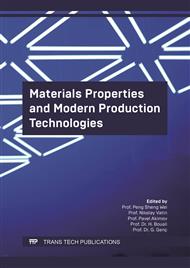[1]
Vorobiev V.A., Andrianov R.A. Polymeric thermal insulation materials. M., Stroyizdat, 1972, p.222.
Google Scholar
[2]
Bruyako M.G., Grigorieva L.S., Ushkov V.A. Operational properties and flammability of modified phenoplastic foam. Vestnik MGSU. 4(2009).
Google Scholar
[3]
Berlin A.A., Shutov F.A. Foam polymers based on reactive oligomers. L.: Chemistry, 1978, p.292.
Google Scholar
[4]
Binka L., Shaver A., «Stavivo». 40(7) (1962) 223 – 225.
Google Scholar
[5]
Foam plastics based on resole phenol-formaldehyde resins for building thermal insulation. Survey information. M., VNIIESM, 1975, p.36.
Google Scholar
[6]
Bruyako M.G, Effective heat-insulating materials based on modified resole phenolic foams. Dissertation. Candidate of Technical Sciences: 05.23.05, Moscow, 2009, p.158.
Google Scholar
[7]
Kiselev V.M., Kuznetsova I.N., Karaznevich V.K., Vinokurov V.A. Pat. 2 034 001 Russian Federation, IPC C08J 9/06 (1995.01). Method of producing foam. Applicant and patentee - Limited Liability Partnership of the Industrial and Commercial Enterprise Teozol,. 5035331/05, declared 04.01.1992, publ. 04.30.(1995).
Google Scholar
[8]
Varlamov P.E., Potatin A.G., Kulikov A.Yu., Nikonov A.S., Prikazchikov K.S. Pat. 2007 145 394 Russian Federation, IPC C08J 9/00. Method of obtaining phenol-formaldehyde foam. Applicant and patentee Limited Liability Company Scientific and Production Association Transpolymer", LLC "Eurostroy,. 2007145394/04; declared 10.12.2007; publ. 06.20.(2009).
Google Scholar
[9]
Mizinova T.P., Mokshin A.I., Tumanov A.S. Pat. 2 213 752 Russian Federation, IPC C08L 61/10 (2000.01). Composition for producing foam. Applicant and patentee Federal State Unitary Enterprise All-Russian Research Institute of Aviation Materials,. 2001131861/04, declared 11.27.2001, publ. 10.10.2003, Bul. 28.
DOI: 10.18577/2071-9170-2015-0-s2-5-10
Google Scholar
[10]
Andrianov R.A., Chistyakov A.M., Duderov Y.G., Mestnikov A.E., Konovalov P.N., Kontorusov S.E. Pat. 2 140 942 Russian Federation, IPC C08L 61/10 (1995.01). Composition for obtaining foam foamresol-NT,. Applicant and patentee Andrianov R.A. Chistyakov A.M., Duderov Yu.G., Mestnikov A.E., Konovalov P.N., Kontorusov S.E., 98109991/04, declared 05.29.1998, publ. 11.10.(1999).
Google Scholar
[11]
Nguyen Viet Kyong, Sosnovsky N.Y., Yanchuk V.P., Smirnova A.M., Grigorieva L.S. Obtaining embedding foamed phenolic plastics of reduced toxicity. Vestnik MGSU. 2019. № 9 (132). URL: https://cyberleninka.ru/article/n/poluchenie-zalivochnyh-penofenoplastov-ponizhennoy-toksichnosti (date of the application: 04.08.2021).
DOI: 10.22227/1997-0935.2019.9.1132-1139
Google Scholar
[12]
Bruyako M.G., Vasilyeva M.A., Kiseleva O.V., Orlova A.M., Sokoreva E.V., Ushkov V.A., Demyanenko A.I., Bruyako O.G. Pat. 2 495 891 Russian Federation, IPC C08L 61/10 (2006.01). Composition for the production of phenolic foam. Applicant and patentee Federal State Budgetary Educational Institution of Higher Professional Education Moscow State University of Civil Engineering,. 2012120393/05, declared 05.17.2012, publ. 10.20.2013, Bul. 29.
DOI: 10.36871/vet.san.hyg.ecol.201904013
Google Scholar
[13]
Dumov S.N., Eremin N.F., Gorlov Yu.P., Toychiev T.T., Musiraliev A.M., Balmagombetov B.Kh., Zhakipov A.M. A.S. 673 645 USSR, IPC C08J 9/04 (2000.01). Composition for the production of foam. 2579281, declared 02.10.1978, publ. 07.15.(1979).
Google Scholar
[14]
TС 6-05-1104-78. Foaming phenol-formaldehyde resins. – Introduction. 1979 – 01 – 01. – M .: StandartInform, 1979, p.11.
Google Scholar
[15]
TС 6-55-1116-88. Product VAG-3. - Introduction. 1988 - 07 – 01. – M .: StandartInform, 1988, p.14.
Google Scholar


